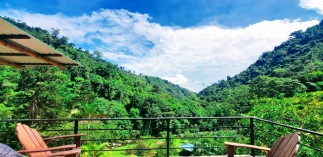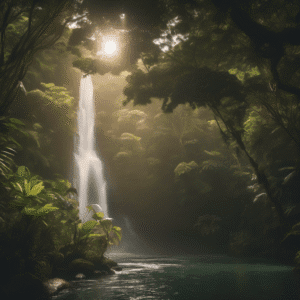Here at our Costa Rican retreat, nestled amidst the emerald embrace of the mountains, we may not have the crashing waves and salty air of the coast. But fear not, bird enthusiasts! Costa Rica’s incredible avian diversity extends far beyond the beaches. Today, we turn our binoculars to a resident of the tropical lowlands, the aptly named Mangrove Swallow (Tachycineta albilinea).
These little dynamos are a dazzling sight. Imagine a jewel come to life – their upper parts shimmer with an iridescent blue-green, catching the sunlight like a beetle’s shell. Black flight feathers provide sharp contrast, while the rump explodes in a brilliant white, a beacon against the lush greenery. Underneath, a gleaming white belly completes the picture of elegance.
But the Mangrove Swallow isn’t just a pretty face. Keep an eye out for the tell-tale white streak above their eye, a supraloral stripe that sets them apart from close cousins like the Violet-green Swallow. Look closely, and you might even notice subtle differences between the sexes – the females tend to have slightly less white on their wings.
While you won’t find them flitting through our mountain retreat, venture down to the Pacific or Caribbean coasts, and you’ve got a good chance of encountering these aerial acrobats. Mangrove forests, coastal lagoons, and even rivers far inland are their playgrounds. They’re rarely alone, flitting about in small groups, often joining forces with other swallow species for a dazzling aerial ballet.
Their life revolves around water. With rapid wingbeats and bursts of gliding, they patrol the skies, scooping up flying insects – their primary source of food. Between feeding forays, they perch on branches or wires, surveying their territory with bright, dark eyes.
The Mangrove Swallow’s breeding season falls between March and August. They favor cavities in trees or human-made structures like nest boxes for raising their young. The parents work tirelessly, bringing back insects to feed their hungry chicks.
While classified as “Least Concern” by international conservation bodies, their populations are showing signs of decline. Habitat loss due to mangrove deforestation is a major threat. So, next time you’re on the coast, take a moment to appreciate these vibrant swallows. Their presence is a reminder of the delicate balance of our ecosystems.
Spotting Tips:
- Look for them near water bodies, especially mangroves and coastal lagoons.
- Watch for small flocks flying low over the water with rapid wingbeats and occasional glides.
- The white rump and supraloral stripe are key identification features.
Listen for: A high-pitched twittering call.
By keeping our eyes peeled and our ears tuned, we can ensure these little flashes of blue continue to grace the Costa Rican skies for generations to come. After your birding adventures, come back to our mountain retreat, where tranquility and breathtaking views await!
For more information, please view our comprehensive guide about the birds of Costa Rica







